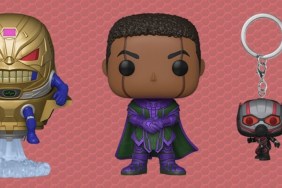"Wow, this TC is an epic troll."
Several days before the release of Marvel vs. Capcom 3, fighting pro and bona fide master at Marvel vs. Capcom 2 Justin Wong sent out several Tweets denouncing its sequel, calling it "the easiest and cheapest fighting game that was ever made". He was immediately lambasted by many MvC fans for being a stuck-up veteran and attention whore who is resistant to change and can't see the obvious awesomeness that is Marvel vs. Capcom 3. I will likely join his company, hopefully for entirely different reasons, but I have to tell it like it is. I'm about to give the game a 'B'.
[image1]But let's preface this by noting that Marvel vs. Capcom 3 deserves the flashiest, most epic letter 'B' in the known universe, or perhaps in a parallel dimension where 'B' is the first letter of the alphabet and Deadpool is president of everything. The MvC series can been called many things – chaotic fan service, epileptic-seizure heaven, slapstick with a touch of WTF – but the point is setting aside the technical inputs and methodical strategies of the standard fighter for the sake of 3-on-3 tag team fun. It's a no-holds-barred fighting bonanza where combos can go over a hundred hits, characters can fill the screen with enough energy projectiles to make Son Goku jealous, and wolves can fire cold beads in mid-air at a psychic demon alien and a pint-sized medieval knight in boxer underwear.
This ridiculousness is only matched by smooth, polished graphics with comic book-styled fonts and 2.5D cel-shading. The vibrancy has a thickness, a weight that settles perfectly between being vivid and being clear. It may not all make sense, but it's not supposed to. Though there are times when the screen goes into sensory overload, it's hard to look away when every frame has about as much eye candy as a double rainbow on crack. The framerate rarely dips, and the disguised loading times keeps the pace high.
Sure, players are free to question the premise of the story: To save the Earth from Galactus, the Devourer of Worlds, all the superheroes and supervillians – our only hope – fight each other in teams of three until only one team is left to handle the planetary crisis by themselves. But by the time they try to apply logic to the situation, the game has already gone over their heads. That said, the character endings that players earn after defeating Galactus – who is cheap but beatable (be careful, though, since losing to the boss counts against your record) – are only several ho-hum comic book panels with text; not exactly the "living comic" we were pitched.
Where Marvel vs. Capcom 3 catches the most controversy is the accessibility of the fighting system. Casual players will call it "approachable" while pros will call it "dumbing it down". This has nothing to do with a reduction in the number of buttons (that hasn't actually changed), but has more to do with the ease of aerial combos and simplified button inputs. Pressing the light, medium, heavy, and special attack button in sequence – or just the special attack button alone – immediately starts the groundwork for an aerial combo where players can inflict further damage with hyper specials and new team aerial combos, which if aren't countered, can inflict heaps of additional damage. Switching characters and calling in assists are as easy as pressing the appropriate partner button. The one-button special Simple mode returns, but with this control scheme, it's not necessary.
[image2]Some MvC veterans, though, believe that's the problem. A part of it is that it flattens the difficulty curve, diminishing hard hours of work for what they see as a shortcut to success. Of course, tourney pros don't have much to worry about; they will still be at the top of the heap, and after a few months, they'll discover how to work the system with ground hits, hit priority, wall bounces, infinite combos, and solid team combinations. Eventually, the popularity of Dante, Deadpool, Sentinel, Zero, and Akuma will be tested and a tier list will emerge. But to their chagrin, Marvel vs. Capcom 3 isn't challenging for them and is too easy to master. This sequel feels like a Marvel vs. Capcom title with the soul of Tatsunoku vs. Capcom, which puts the question of whether it's a true sequel on the table, though MvC3 has no obligation to follow its predecessor to the letter.
As someone who sits firmly in between the casual and hardcore crowds, I am torn. On one hand, leveling the playing field makes it easier for me to reach top-tier play and broadening the audience of fighting titles is important for sustaining the genre. The once-per-battle X-Factor ability can be seen as a get-out-of-jail free card, but giving both teams the X-Factor ability maintains balance (Dark Phoenix with Level 3 X-Factor notwithstanding). On the other hand, I've watched an 11-year old button-mash his way through six rounds of Normal difficulty without looking at the screen.. and then be destroyed by Galactus. Perhaps it's poetic justice, but Normal difficulty should be rewarding him to play appropriately from the very beginning.
Almost equally as controversial is the roster list, which favors newer characters over classic ones. The surprising absence of eight mainstays in the MvC series – Strider Hiryu, Captain Commando, Gambit, Jin, Megaman, Venom, War Machine, and Zangief – have been replaced with over half a roster's worth of debut characters to represent newer Capcom franchises like Bionic Commando, Devil May Cry, and Okami as well as a variety of semi-familiar Marvel comics. Taking a step back, the roster feels a tad eclectic to feel right at home.
Players can debate all day on whether 36 (plus 2 more) 2.5D characters is a far cry to 56 sprite-based characters in MvC2, and whether certain characters deserve to take the place of their favorites, but the assumption – or overwhelmingly obvious speculation – is that Capcom will be dishing out DLC character packs (and costume packs), probably at $10 for two characters if the Collector's Edition pack with Jill Valentine and Shuma Gorath is any indication. That ultimately means that fans will be pressured, out of balance or completion, to spend much more, if not twice the retail price all together, within the coming months. It just feels like they're holding the actual full game hostage, all while knowing that their loyal fans will still purchase the future packs even if they get bitter. ("MvC3 Ultimate Edition"? Oh, no, I didn't…)
[image3]On the upside, the online lobbies are fairly robust, connection speeds are good and will get better, and the license card is quick and easy. There, players will get a rundown of their overall progress, win-loss ratio offline and online, character frequency usage, and all the titles and icons they have unlocked. Better yet, the goals for acquiring a specific title are given directly to remove any guesswork.
Unfortunately, several features are inexplicably missing. Online lobbies do not have spectator mode and players can't save or watch replays, surprising only because Super Street Fighter IV had already nailed this down. Though multiple matches can take place within a lobby, the inability to observe other players hinders the growth of the community and sometimes forces standby players to twiddle their thumbs. Rumors are that Capcom will patch spectator mode in soon, though it should have been there in the first place. There is also no option to play against the CPU in versus mode, no gauge for speed, no "Perfect" call when a perfect game actually happens, and no other variant modes other than Mission combo trials. After playing Arcade and Online for about four hours, there's not much else to do.
On top of that, the music is mostly forgettable, with several tracks for the character selection screen sounding like they come straight out of Dance Dance Revolution rip-off. This includes a remixed version of the dreaded "Take Me for a Ride!" theme. It's unclear why the background music isn't simply replaced by some of the cooler remixed character themes featured in the game's gallery; either that or the ability to uncheck songs that players don't want to hear. Otherwise, it's better to turn the music off. Most of the voice-acting is fine, but there are a few abrupt moments, particularly Spiderman's "Web swing!" and a few lines that are spoken over and over again when a character is hit, like Wesker's "You're going to pay for that!".
No doubt, Marvel vs. Capcom 3 will continue to sell for weeks on end regardless of what one person says, but there will likely be a handful of returns and rentals. Its approachable, eye-catching flair matches most of the hype and is sure to be a crowd-pleaser, though veterans may feel slighted by the simplified control scheme. While the roster and the overall features are competent, there is deliberately plenty of room to grow with DLC and patches for not just the upcoming Shadow Mode, but more characters, modes, and features that are supposed to be available at launch. Given a few months, this 'B' will likely become a solid 'B+'. Until then, the riotous excitement for Marvel vs. Capcom 3 is smeared by a thin but visible layer of disappointment.
-
Slapstic, fantastic, spastic, cracktastic!
-
Slick and bold comic-book eye candy
-
Gameplay more accessible to everyone...
-
...but also a bit dumbed down in the process
-
Good online lobbies and license card stats
-
...but no spectator mode yet
-
Competent roster list many new characters...
-
...but some glaring omissions (for DLC)
-
Forgettable music
-
No extra modes beyond Mission







